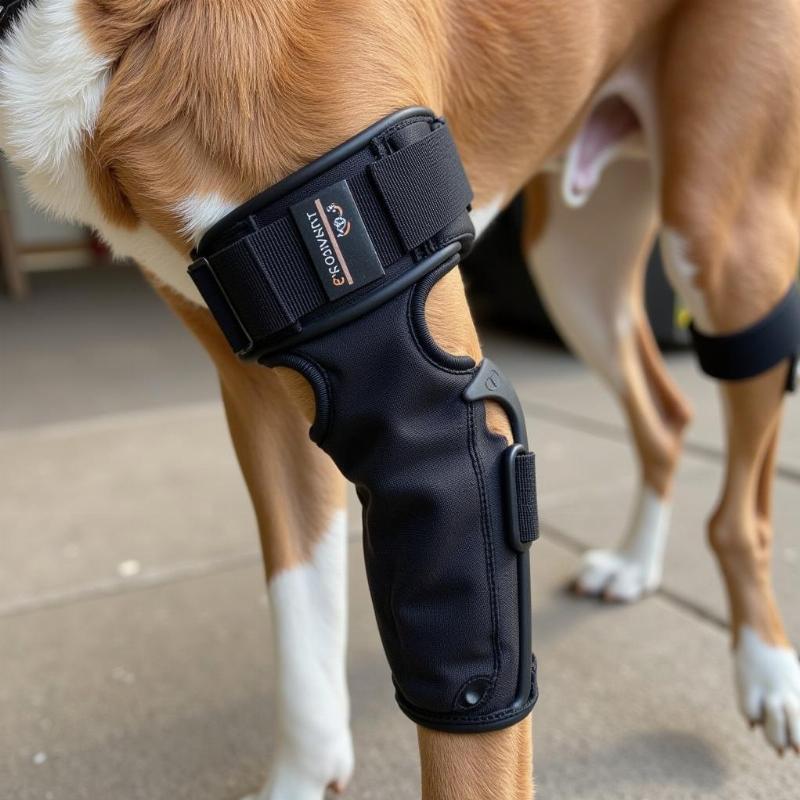TPLO surgery, or Tibial Plateau Leveling Osteotomy, is a common procedure for dogs with cranial cruciate ligament (CCL) tears. However, it’s a significant surgery, and some pet owners explore alternatives. This article will delve into non-surgical and less invasive options for managing CCL injuries in dogs, providing valuable insights for concerned owners in the United States.
Exploring Non-Surgical Alternatives for CCL Tears
Non-surgical management can be suitable for some dogs, especially smaller breeds or those with partial tears. These methods focus on pain management, rehabilitation, and lifestyle adjustments. Is TPLO always the answer? Not necessarily. Let’s examine the options.
Conservative Management for CCL Injuries
Conservative management involves rest, weight management, physical therapy, and pain medication. This approach can be effective for minor tears or for dogs where surgery isn’t feasible due to age or other health concerns. It’s a crucial first step even before considering surgery.
- Rest and Restricted Activity: Limiting your dog’s movement is essential for healing. This means no running, jumping, or playing fetch for several weeks. Short, leashed walks for bathroom breaks are permitted.
- Weight Management: Maintaining a healthy weight reduces stress on the injured knee. Consult your veterinarian for a tailored weight loss plan if needed. Every extra pound adds strain to the already compromised joint.
- Physical Therapy: A certified canine rehabilitation therapist can design a program to strengthen supporting muscles and improve joint stability. This can include exercises, stretches, and modalities like laser therapy or underwater treadmill therapy.
- Medications: Non-steroidal anti-inflammatory drugs (NSAIDs) can help manage pain and inflammation. Your veterinarian will prescribe the appropriate medication and dosage for your dog. Never give human medications to your pet.
Bracing and Orthotics for Canine CCL Injuries
Braces and orthotics can provide support and stability to the injured knee, reducing pain and improving mobility. These devices can be used in conjunction with conservative management or after surgery to aid in recovery.
- Custom vs. Off-the-Shelf Braces: Custom-made braces offer a more precise fit and may provide better support. Off-the-shelf options can be more affordable and readily available.
- Proper Fitting and Usage: It’s essential to have the brace fitted correctly by a professional. Incorrect usage can exacerbate the injury. Follow your veterinarian’s instructions carefully.
 Dog Wearing Knee Brace
Dog Wearing Knee Brace
When is Surgery Necessary for CCL Tears in Dogs?
While conservative management can be effective in some cases, surgery is often the best option for complete tears, larger breeds, or active dogs. If non-surgical methods fail to provide adequate pain relief and stability, surgery might be necessary. affordable tplo surgery for dogs offers helpful information about affordable TPLO surgery.
TPLO Alternatives: Exploring Surgical Options
Besides TPLO, other surgical procedures can address CCL tears. These include:
- TTA (Tibial Tuberosity Advancement): This procedure alters the biomechanics of the knee to stabilize the joint without the CCL.
- Extracapsular Repair: This involves placing a synthetic ligament outside the joint capsule to provide stability. This is generally less invasive than TPLO or TTA but may not be suitable for all dogs.
- TightRope® Technique: This technique uses a synthetic suture to mimic the function of the CCL.
Post-Operative Care and Rehabilitation
Regardless of the chosen treatment, post-operative care and rehabilitation are crucial for a successful recovery. dog limping 2 years after tplo provides insights into potential complications and solutions. how do dogs sleep with cone will offer practical advice to make your dog’s recovery more comfortable.
Expert Insight: Dr. Emily Carter, DVM, a board-certified veterinary surgeon in New York, emphasizes, “Post-operative rehabilitation is as important as the surgery itself. A tailored rehabilitation program can significantly improve recovery time and long-term outcome.”
Expert Insight: Dr. Michael Davis, a Certified Canine Rehabilitation Therapist, adds, “A combination of controlled exercise, manual therapy, and modalities like laser therapy can greatly benefit dogs recovering from CCL injuries, whether they’ve had surgery or not.”
Conclusion
Choosing the best treatment for your dog’s CCL tear requires careful consideration of various factors, including the severity of the tear, your dog’s size, age, and activity level. While TPLO surgery is a common and effective option, exploring alternatives to TPLO surgery for dogs is essential to make informed decisions for your furry friend. Consult with your veterinarian to determine the most appropriate course of action.
FAQ
- Is TPLO surgery always the best option for CCL tears? No, TPLO isn’t always necessary. Non-surgical options or alternative surgical procedures may be more suitable depending on individual circumstances.
- How long is the recovery period after TPLO surgery? Recovery typically takes several months, with restricted activity and rehabilitation being crucial during this period.
- What are the signs of a CCL tear in dogs? Common signs include limping, stiffness, swelling in the knee joint, and difficulty bearing weight on the affected leg.
- Can a dog live a normal life after CCL surgery? Yes, most dogs can return to a normal, active life after successful surgery and rehabilitation.
- How much does TPLO surgery cost? The cost varies depending on location and veterinary practice but typically ranges from $3,000 to $5,000.
- Are there financial assistance programs for pet surgeries? Yes, several organizations offer financial aid for pet owners facing veterinary expenses. Research options available in your area.
- What can I do to prevent CCL tears in my dog? Maintaining a healthy weight, providing regular exercise, and avoiding high-impact activities can help reduce the risk of CCL injuries.
Related Articles
Beautdogs.us: Your Trusted Source for Dog Care
Beautdogs.us is your one-stop resource for comprehensive and engaging information on dog breeds, care, and products specifically tailored to the American dog owner. Whether you’re a seasoned dog parent or just starting your journey, Beautdogs.us provides expert advice, practical tips, and product recommendations to help you navigate the world of dog ownership. From understanding breed specifics to finding the perfect dog-friendly destinations, we’re here to support you every step of the way. Contact us for personalized guidance at [email protected] or +1 501-555-7529.